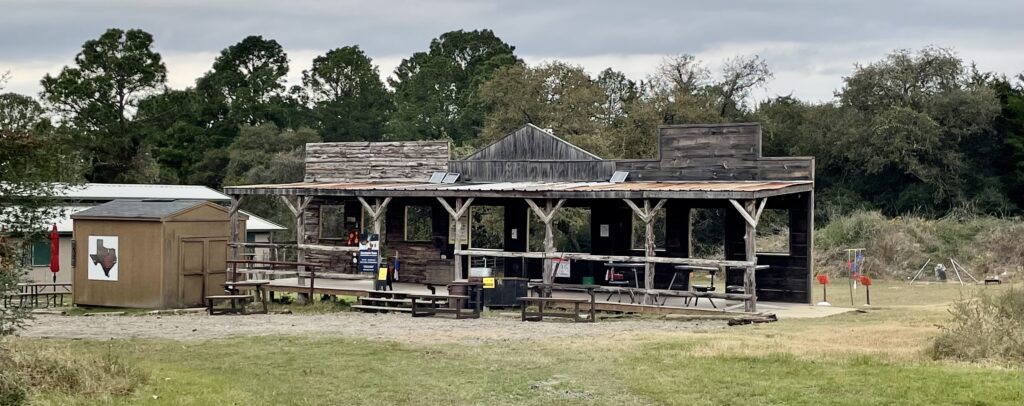ATF ARM BRACE UPDATE: (as of 1/31/23)
Click here to review the details from the ATF
Factoring Criteria for Firearms with Attached “Stabilizing Braces”

On January 13, 2023, the Attorney General signed ATF final rule 2021R-08F, “Factoring Criteria for Firearms with Attached ‘Stabilizing Braces,’” amending ATF’s regulations to clarify when a rifle is designed, made, and intended to be fired from the shoulder.
The rule outlines the factors ATF would consider when evaluating firearms equipped with a purported “stabilizing brace” (or other rearward attachment) to determine whether these weapons would be considered a “rifle” or “short-barreled rifle” under the Gun Control Act of 1968, or a “rifle” or “firearm” subject to regulation under the National Firearms Act. The rule’s amended definition of “rifle” clarifies that the term “designed, redesigned, made or remade, and intended to be fired from the shoulder” includes a weapon that is equipped with an accessory, component, or other rearward attachment (e.g., a “stabilizing brace”) that provides surface area that allows the weapon to be fired from the shoulder, provided other factors, as listed in the definition, indicate the weapon is designed and intended to be fired from the shoulder.
This rule does not affect “stabilizing braces” that are objectively designed and intended as a “stabilizing brace” for use by individuals with disabilities, and not for shouldering the weapon as a rifle. Such stabilizing braces are designed to conform to the arm and not as a buttstock. However, if the firearm with the “stabilizing brace” is a short-barreled rifle, it needs to be registered within 120-days from the date of publication in the Federal Register.
This rule is effective the date it is published in the Federal Register. Any weapons with “stabilizing braces” or similar attachments that constitute rifles under the NFA must be registered no later than 120 days after date of publication in the Federal Register; or the short barrel removed and a 16-inch or longer rifle barrel attached to the firearm; or permanently remove and dispose of, or alter, the “stabilizing brace” such that it cannot be reattached; or the firearm is turned in to your local ATF office. Or the firearm is destroyed.
Please note that this is the text of the final rule as signed by the Attorney General, but the official version of the final rule will be as it is published in the Federal Register. The rule will go into effect once it is published in the Federal Register.
Pistol Brace Amnesty Period
Included in rule 2021R-08F is a 120-day forbearance period, that started January 31, 2023, when the rule was added to the Federal Register. This ATF pistol brace amnesty period will serve as a window to give individuals time to comply with the new definition and rule by removing the brace, installing a barrel 16” or longer, registering the firearm as an SBR, or destroying the braced weapon. After the forbearance period concludes, firearms that are determined to be SBRs will be treated as unregistered NFA items, and penalties for possessing an unregistered SBR include fines of up to $250,000, up to 10 years in federal prison, and the loss of gun rights.
Do I Need a Tax Stamp for a Pistol Brace?
Yes, if your braced weapon meets the new criteria to be considered an SBR it will require a tax stamp to remain in that configuration. The new ruling does state that during the forbearance period, the ATF will waive the cost of an NFA tax stamp for those who choose to register their firearm as a short-barreled rifle. Registration can be done as an individual or a trust as long as the trust owned the firearm prior to the final rule being added to the register. This registration would be done via an ATF Form 1, which is the form required to manufacture an NFA item.
Who is Affected by this Rule?
- Unlicensed Possessors
- Federal Firearms Licensees (FFLs) not under the NFA as a Class One Importer or Class Two Manufacturer SOT
- FFL Importers or Manufacturers under the GCA that ARE Qualified under the NFA Class One Importer or Class Two Manufacturer SOT
- Certain Governmental Entities
What Do You Need to Know?
Affected parties are provided a range of options to remain in compliance with rule 2021R-08F. ATF has provided this quick reference sheet to provide these options. For questions not answered by the reference sheet, we have provided a comprehensive list of FAQs.
If you are an FFL (Types 01/02/07, non-SOT):
 You MUST remove all arm braces from AR pistol firearms whether or not you are a Class 3 SOT holder. An AR pistol is any AR-type firearm with a barrel length of less than 16 inches.
You MUST remove all arm braces from AR pistol firearms whether or not you are a Class 3 SOT holder. An AR pistol is any AR-type firearm with a barrel length of less than 16 inches.
 The AR pistols with arm braces attached will immediately become a Short-Barreled Rifle which is “an NFA regulated firearm” if the arm brace is attached and if the barrel length is less than 16 inches in length.
The AR pistols with arm braces attached will immediately become a Short-Barreled Rifle which is “an NFA regulated firearm” if the arm brace is attached and if the barrel length is less than 16 inches in length.
 Separate the arm braces from the firearm it was removed from. If the brace was removed from the AR pistol prior to the publishing of the new ruling, it is our interpretation that the arm braces are “accessories” and may be sold as such.
Separate the arm braces from the firearm it was removed from. If the brace was removed from the AR pistol prior to the publishing of the new ruling, it is our interpretation that the arm braces are “accessories” and may be sold as such.
 If the arm brace is removed AFTER the publication of the new ruling, the ruling states that the arm brace must be removed and destroyed or altered and “made unusable”.
If the arm brace is removed AFTER the publication of the new ruling, the ruling states that the arm brace must be removed and destroyed or altered and “made unusable”.
 Following publication of the ruling, it will be illegal to provide/transfer/sell/return (pawn redemptions) the removed arm brace with the AR pistol from which it was removed.
Following publication of the ruling, it will be illegal to provide/transfer/sell/return (pawn redemptions) the removed arm brace with the AR pistol from which it was removed.
 The PRIMARY FACTOR that determines if your AR firearm is a pistol or a rifle is the barrel length. Less than 16 inches=pistol. No stabilizing arm brace permitted. If the barrel is 16 inches or longer = arm brace can remain attached.
The PRIMARY FACTOR that determines if your AR firearm is a pistol or a rifle is the barrel length. Less than 16 inches=pistol. No stabilizing arm brace permitted. If the barrel is 16 inches or longer = arm brace can remain attached.
 There are many variations of which arm braces are/are not deemed “restricted” so please refer to THIS ATF LINK for more examples of what is/is not “permissible”. Our advice is to “remove them all” to comply with the new ruling and then conduct additional research for legality and reinstallation.
There are many variations of which arm braces are/are not deemed “restricted” so please refer to THIS ATF LINK for more examples of what is/is not “permissible”. Our advice is to “remove them all” to comply with the new ruling and then conduct additional research for legality and reinstallation.
 Arm Braces that are removed prior to the ruling may be returned /sold to customers, sold as “accessories” and included with pawn redemptions.
Arm Braces that are removed prior to the ruling may be returned /sold to customers, sold as “accessories” and included with pawn redemptions.
 Arm braces removed after the ruling publication cannot be sold/transferred with the AR pistol from which it was removed and must be destroyed/ altered / made unusable. The ruling does not clearly explain if the removed arm braces may be sold separately as accessories.
Arm braces removed after the ruling publication cannot be sold/transferred with the AR pistol from which it was removed and must be destroyed/ altered / made unusable. The ruling does not clearly explain if the removed arm braces may be sold separately as accessories.
 We have CONFIRMED that imported AR pistols that have arm braces attached may have their braces removed. There was some “internet confusion” on this part of the ruling (ref: page 264). In the majority of cases, the AR pistols that have arm braces attached had the “arm brace accessories” installed post-importation so the same 5 options for remedy exist.
We have CONFIRMED that imported AR pistols that have arm braces attached may have their braces removed. There was some “internet confusion” on this part of the ruling (ref: page 264). In the majority of cases, the AR pistols that have arm braces attached had the “arm brace accessories” installed post-importation so the same 5 options for remedy exist.
 From the ATF: “Possessors of an imported pistol that had a stabilizing brace added to it after it was imported, have the same five options as all current unlicensed possessors, FFL/non-SOT, and FFL SOT holders.
From the ATF: “Possessors of an imported pistol that had a stabilizing brace added to it after it was imported, have the same five options as all current unlicensed possessors, FFL/non-SOT, and FFL SOT holders.
With regards to pawned firearms, the current possessor, in this case the pawnshop, has the same five options as all FFL/non SOT holders. All possessors must also be in compliance with state and local laws.”
 The “length of trigger pull” and whether or not you have a scope attached to your AR pistol for “eye relief” can also deem your AR pistol to be a short-barrel rifle BUT the arm brace should be the primary factor to consider.
The “length of trigger pull” and whether or not you have a scope attached to your AR pistol for “eye relief” can also deem your AR pistol to be a short-barrel rifle BUT the arm brace should be the primary factor to consider.
 FFLs are required to comply with the new ruling AS SOON AS the ruling is published. (NO grace period). If an FFL keeps an arm brace attached to an AR pistol on the licensed premises, steps must be initiated to complete a FORM 1 to register the firearms with the NFA branch and proof of registration submittal must be available for inspection. No SBR/regulated firearm may be transferred until a. it is registered with the NFA branch and b. a Form 4 is completed for the transfer. Again> REMOVE your arm braces as soon as possible.
FFLs are required to comply with the new ruling AS SOON AS the ruling is published. (NO grace period). If an FFL keeps an arm brace attached to an AR pistol on the licensed premises, steps must be initiated to complete a FORM 1 to register the firearms with the NFA branch and proof of registration submittal must be available for inspection. No SBR/regulated firearm may be transferred until a. it is registered with the NFA branch and b. a Form 4 is completed for the transfer. Again> REMOVE your arm braces as soon as possible.
 Non-licensees (customers, individuals) will have up to 120 days from the date of publication to decide what to do with their AR pistols with stabilizing arm braces attached.
Non-licensees (customers, individuals) will have up to 120 days from the date of publication to decide what to do with their AR pistols with stabilizing arm braces attached.
The BATFE will implement rule changes to “firearms with an attached stabilizing brace” on JUNE 1ST, 2023.
Who – What – Where:
Most AR fans are familiar with “AR pistols” and stabilizing arm braces. AR pistols are considered to be AR platform firearms with barrels under 16 inches in length (the minimum length for a non-NFA rifle) and lacking any device intended to make the firearm operational via shoulder mounting (fired from the shoulder).
- In other words, a conventional AR buttstock mounted to a sub-16-inch barrel AR firearm is considered by the BATFE to be a short-barrel rifle, not a pistol. Such a firearm is regulated under the National Firearm Act and requires a proper BATFE application and NFA tax stamp to be legally possessed.
Last summer, the BATFE signaled their intent to eliminate the “stabilizing brace” exemption because they felt legal gun owners were abusing the design intent of the stabilizing brace, using the devices as a “shoulder mount workaround” as opposed to the intended purpose of stabilizing an AR pistol against the support arm. Cries of protest from the shooting community and industry notwithstanding, the BATFE moved forward with their plan to remove the stabilizing brace exemption for AR pistols, effectively classifying former AR pistols with stabilizing braces as NFA short-barrel rifles.
- According to BATFE published documentation, the final rule will go into effect in JUNE 1ST this year(2023). Everyone who wants to continue legal possession of their AR pistol with an arm brace MUST submit a NFA Form 1, pay the $200 NFA tax stamp, and receive final approval from the BATFE to convert their pistol to a short-barrel rifle.
You may be wondering why, with such a large number of firearm owners being impacted by this rule change (the cost to the individual being, at minimum, the financial loss of their arm brace or $200 for the NFA tax stamp), the BATFE would not at least “grandfather in” all existing AR pistols with stabilizing braces?
- Well, you can wonder all you like, but it’s not happening. According to the BATFE, “Without this rule, public safety will continue to be threatened by the criminal use of such firearms, which are easily concealable from the public and first responders.”
The net result: criminals aren’t going to AND law-abiding gun owners are going to suffer more restrictive rules, regulations, and financial impact.
Since this new regulation will certainly not be rolled back during the span of the current administration, we are left with few options. Here they are per the BATFE:
- Options for Affected Persons
As mentioned, ATF wants to assist affected persons or companies and is providing additional information to aid them in complying with Federal laws and regulations. Below are options for those persons that may be affected upon publication of a final rule.
- Current Unlicensed Possessors
In order to comply with the provisions of the NFA, current unlicensed possessors of a firearm equipped with a “stabilizing brace” and a barrel length of less than 16 inches that would qualify as a “short-barreled rifle” as indicated on the ATF Worksheet 4999 contained in this proposed rule would need to take one of the following actions before the effective date of a final rule.
(1) Permanently remove or alter the “stabilizing brace” such that it cannot be reattached, thus converting the firearm back to its original pistol configuration (as long as it was originally configured without a stock and as a pistol) and thereby removing it from regulation as a “firearm” under the NFA. Exercising this option would mean the pistol would no longer be “equipped with” the stabilizing brace within the meaning of the proposed rule.
(2) Remove the short barrel and attach a 16-inch or longer barrel to the firearm thus removing it from the provisions of the NFA.
(3) Destroy the firearm. ATF will publish information regarding proper destruction on its website, www.atf.gov.
(4) Turn the firearm into your local ATF office.
(5) Complete and submit an Application to Make and Register a Firearm, ATF Form 1 (“Form 1”). As part of the submission, the $200 tax payment is required with the application. Pursuant to 27 CFR 479.102, the name, city, and state of the maker of the firearm must be properly marked on the firearm. All other markings, placed by the original manufacturer, should be adopted. Proof of submission of the Form 1 should be maintained by all possessors. Documentation establishing submission of Form 1 includes, but is not limited to, eForm submission acknowledgement, proof of payment, or copy of Form 1 submission with postmark documentation.
Obviously, options 3 and 4 are non-starters. Option 1 results in the financial loss of the stabilizing brace and reduces practical function of the firearm. Option 2 has merit, but it nullifies the firearm’s mobility and CQB effectiveness — the very reasons many personal defense practitioners acquired an AR-platform pistol in the first place.
For most of us, option 5 is the best option. By submitting Form 1, paying the NFA tax stamp, and receiving BATFE approval, the AR pistol with a stabilizing brace becomes a legal-to-possess NFA short-barrel rifle. Yes, you spent $200 on the tax stamp, but you saved the cost of the arm brace (should you decide to keep it) and can now shoulder the rifle for operation. Better yet, in our opinion, this allows you to install a proper buttstock, providing much-improved function and accuracy potential.
Of course, the ability to “convert” your AR pistol to a short-barrel rifle is dependent upon state and local laws, so you will need to check with the proper authorities before going down this road.
Should you decide that you want to convert your pistol to an SBR, we have a bit of good news. The process is fairly simple thanks to the recently introduced BATFE eForm application process. This new electronic filing system eliminates the old paperwork submission circus and makes the application process quicker and more efficient. Word on the street is that the turnaround time for application approval runs 60-90 days. We’ve heard that it can be much quicker than that.
The only non-electronic part of the process is obtaining and submitting your fingerprints on the approved FD-258 fingerprint card.
The caveat is that once you have completed the electronic Form 1 and have received the cover letter from the BATFE (which must accompany the fingerprint cards), you only have 10 days to get the fingerprint cards and cover letter to the BATFE. So, definitely get your fingerprints taken care of BEFORE you start the filing process.
Owners of AR pistols with stabilizing braces are certainly being served a crap sandwich with these new rules. For now, it looks as if we’re going to have to swallow it. The important thing is that the window is fast closing for compliance.
If you want to keep enjoying your AR pistol with any accessories you want, then it’s time to legally transform it into a short-barreled rifle (SBR) by registering it as an NFA gun. It’s not as difficult as you think. We’re about to walk you through the whole process with written and video guides:
- Filling out and submitting the SBR application online.
- Rolling your own fingerprints on FD-258 fingerprint cards.
- Mailing your prints to the ATF so your application gets approved.
You can use these guides whether you want to convert a pistol or build an AR-type SBR from scratch. The steps are also the same whether you’re using an 80% lower (plus engraving requirements, which we’ll touch on later) or a stripped lower receiver you bought from an FFL. Let’s start with common questions.
TEXAS TO THE RESCUE:
(AS OF 6/2/2023)
- An administrative rule issued by the Biden administration redefining a popular stabilizing pistol brace as a short-barreled rifle (SBR) went into effect on June 1, but only after several federal district courts in Texas issued injunctions blocking enforcement against gun rights groups and their members.
- Three lawsuits were filed in separate federal district courts across Texas earlier this year, resulting in last-minute intervention granting injunctions to protect the plaintiffs and their organization’s membership from the rule’s enforcement.
- Gun Owners of America (GOA) filed a lawsuit in conjunction with the Texas Office of the Attorney General (OAG) in the Southern Federal District Court of Texas, where Judge Drew Tipton issued a preliminary injunction Wednesday blocking enforcement of the rule against GOA members, their immediate family members, and employees of the State of Texas.
- “This assault on millions of Americans was just the latest example of President Biden trying to weaponize the DOJ against law-abiding gun owners. We doubt it will be the last,” GOA Vice President Eric Pratt said in a statement on the ruling. “We are incredibly grateful to Judge Tipton for hearing the pleas of our members who were facing serious prosecution simply for owning a piece of plastic – all because of an arbitrary reclassification by the [Bureau of Alcohol, Tobacco, Firearms and Explosives].”
- The Wisconsin Institute for Law and Liberty (WILL) also filed a lawsuit challenging the rule’s constitutionality on behalf of Amarillo resident Darren Britto. The Northern District Court of Texas granted an injunction against enforcement of the rule only to the plaintiffs named in the case.
- Another such group, the Firearms Policy Coalition (FPC), prevailed in winning an injunction before the U.S. Fifth Circuit Court of Appeals.
- A May 26 clarification issued by the court explained that customers and members of FPC, including their resident family members, are protected by the court order from enforcement of the pistol brace rule.
- The case, styled Mock v. Garland, originated in the Northern District of Texas and was appealed after the district court first declined to block the rule.
How to Legally Convert an AR Pistol Into an SBR
Posted by 80-Lower.com on Jun-26-2021
The ATF Wants To Ban Pistol Braces. The agency published a List Of “Criteria“ for determining whether your AR-15 pistol, when equipped with a brace, will instead be considered an illegal short-barreled rifle. If you want to keep enjoying your AR pistol with any accessories you want, then it’s time to legally transform it into a short-barreled rifle (SBR) by registering it as an NFA gun. It’s not as difficult as you think. We’re about to walk you through the whole process with written and video guides:
- Filling out and submitting the SBR application online.
- Rolling your own fingerprints on FD-258 fingerprint cards.
- Mailing your prints to the ATF so your application gets approved.
You can use these guides whether you want to convert a pistol or build an AR-type SBR from scratch. The steps are also the same whether you’re using an 80% lower (plus engraving requirements, which we’ll touch on later) or a stripped lower receiver you bought from an FFL. Let’s start with common questions.
ATF eForm 1 Walkthrough
With Silencer Shop’s ATF eForm 1 service, filing for an SBR is easy.
- Login to your Silencer Shop account: if you don’t have an account you can quickly create one by selecting “Register as a “New User”. From the Dashboard, navigate to “eForm 1” on the top banner and click the “Start New Form 1” button. You’ll then be prompted to choose whether your submission will qualify for tax-exemption based on ATF pistol brace amnesty rule.
- You will need to enter a few pieces of information: We request a photo of the original engravings, including the manufacturer, model, caliber, city, and state. You will also need to enter this info in the appropriate fields. Input the barrel length and overall length that the firearm will have in its SBR configuration.
- Once your information is input:a member of our compliance team reviews your application packet and checks it for accuracy (Silencer Shop compliance has a 99.5% accuracy rate compared to the industry average of 60%).
- Upon a successful compliance review: your eForm 1 will be prepped for submission. You will get an email from DocuSign, please verify the information is correct and accept it. Then just look out for a “Ready to Certify” email, be aware this sometimes gets filtered to Junk/Spam folders.
- Certification can be done quickly and easily: from your own computer or mobile device right at home, just make sure to have your ATF eForms login and password ready!
Important Notes:
After you submit your Form 1 through Silencer Shop, the ATF will send you an email titled: “eForms Application Submission Notification for Permit/Control No: ######”. This email has an attachment asking you to submit your fingerprints. Silencer Shop does this for you!
If you need any assistance, hovering over the “Need help” question mark (?) icons will provide useful information on how to fill out the indicated field.
Litigation and Lawsuits
Many law-abiding citizens are upset about the new pistol brace rule, calling it a registration scheme or a bait and switch by the ATF, which previously approved the use of pistol braces and braced weapons. Organizations such as the Firearms Regulatory Accountability Coalition (FRAC), The Second Amendment Foundation (SAF), and National Rifle Association (NRA) are leading the charge to oppose this rule with litigation and lawsuits against the ATF. These groups and others are calling the ruling an attack on the 2nd amendment and citing that only Congress can establish laws, not regulatory bodies such as the DOJ or ATF. We encourage you to support the organizations that are battling to make sure our gun rights shall not be infringed.
Converting to an SBR: FAQs
Q: What’s an AR-15 pistol?
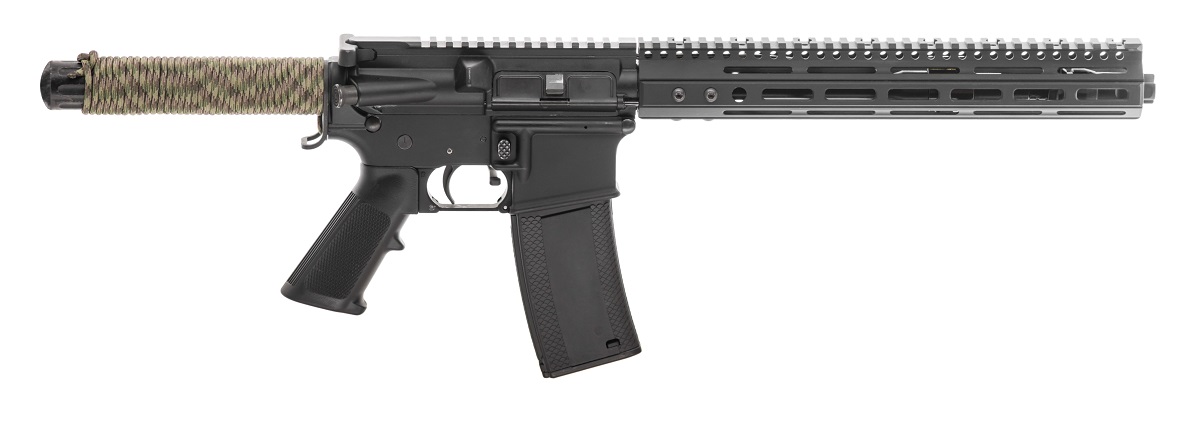
A: An AR-15 pistol is an AR-15 with a barrel length less than 16″, and no vertical foregrip or stock installed on the buffer tube. If the ATF gets their way, you won’t be able to use a pistol stabilizing brace with virtually any other accessories (like angled foregrips, sights, or optics of any kind) either. You also won’t be able to own an AR pistol longer than 26″ or heavier than 7.5 pounds (120 ounces) with a brace. It’ll automatically be considered an SBR.
Q: What is a short-barreled rifle?
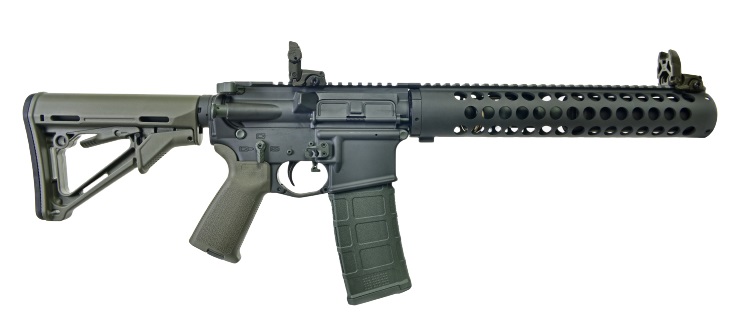
A: A short-barreled rifle, or SBR, is currently defined as a rifle with a barrel shorter than 16″ and that has a buttstock installed. After the ATF squeezes its arbitrary rule-making through, most pistol braces will be treated as buttstocks.
Q: How do I legally convert my AR-15 pistol into an SBR?
A: You must create an account and fill out an application on the ATF’s EForms Website. Commonly called a “Form 1” application by gun owners and builders, it’s officially labelled ATF Form 5320.1, Application to Make and Register a Firearm. Getting an approved application means your firearm is now legal under the National Firearms Act (NFA), which regulates certain classes of firearms and suppressors.
Q: Can I convert my 80% lower into an SBR?
A: Yes, you can. But this will require you engrave a model, serial number, your name, and the city and state where you fabricated it. This information needs to be provided on the Form 1 application for the ATF to approve your SBR.
Q: Is this legal to do in all 50 states?
A: No. Counter to federal gun laws, some states have effectively outlawed ownership of NFA firearms, including short-barreled rifles. Always check your local and state laws before attempting to process an ATF application for a firearm.
Q: Can I turn my AR pistol into a regular rifle?
A: Yes, and you do not have to file any NFA application or submit to the ATF’s bureaucracy. It’s entirely legal to throw a buttstock on your AR pistol and turn it into a regular rifle if you first install a barrel that’s 16″ or longer. Muzzle devices do not count as part of the barrel length unless they’re permanently installed (pinning and welding).
Q: What does filling out the Form 1 require?
A: The Form 1 application is like a more involved version of the background check paperwork that you fill out when you purchase a firearm through an FFL. The application can be filled out and submitted online. You’ll provide your name and address, and a brief description of your future SBR. You’ll list the name and location of the maker (that’s you!), serial number, caliber, and the overall length of the rifle. You’ll make up an alphanumeric serial number if you’re using an 80% lower.
Q: How long does it take to complete a Form 1 application?
A: Filling out the online application and uploading your photo takes as little as 30 minutes. Rolling your fingerprints is surprisingly easy and only takes around 30 minutes, too.
Q: What’s this about rolling fingerprints and taking my photo?
A: When you fill out your online application, you’ll need to upload a picture of yourself. You can take a selfie at home with your cellphone against any bare wall and upload it. After submitting the online application, you’ll need to fill out and mail two fingerprint cards to the ATF.
Q: How do I take and submit my fingerprints?
A: The ATF requires your prints be rolled on FD-258 Fingerprint Cards. They’ll provide you with an email and a .PDF “cover letter” with further instructions. We have a guide rolling and mailing your fingerprints with the .PDF letter linked below.
Q: How long does it take for a Form 1 application to be approved?
A: Approval times can vary greatly. Currently, most Form 1 applications for SBRs appear to take between 30 and 90 days for approval. This writer submitted an SBR application on JUNE 1ST.
Q: What happens when my SBR’s application is approved by ATF?
A: You can throw on your buttstock if you’re converting a pistol, or build your SBR if you’re assembling it from scratch, then hit the range! Once your application is approved, the ATF will notify you via email. You will not receive a physical, mailed copy of your tax stamp. You must instead download it and keep it for your records.
Q: Can I modify my SBR’s barrel length or overall length later?
A: Yes. The ATF requests you notify them in writing of a permanent change to your SBR’s length, but you are allowed to swap upper receivers, buttstocks, and even barrels at will. These modifications can be considered temporary unless you discard the original upper, stock, or barrel. In this case, such changes don’t meet the requirements of notifying the ATF.
Now, let’s get into the big details about how to successfully – and legally – convert your AR pistol into an SBR.
1. Start Your AR Build
If you don’t already own an AR pistol, now is the time to start building one. Since you need some info about your future SBR’s setup for the Form 1 application (like overall length and a serial number), it makes sense to start buying the parts required for your rifle before you complete your application. Even with the ATF’s upcoming pistol brace ban, AR pistols will still be legal to own. You just won’t be able to install a brace on your buffer tube. That means configuring your future SBR as a pistol first, then buying and installing your buttstock after the application is approved.
Pick a Lower Receiver (80% vs. Stripped)

All NFA guns require a serial number, but this doesn’t mean you can’t Use An 80% Lower for your SBR. You get to make up your own serial number and have it engraved on the 80% lower receiver you fabricated. Or, you can use a stripped lower receiver with a serial number already engraved.
(Don’t build an AR-15 pistol with a rifle lower!)
If you’re turning a regular AR-15 rifle into an SBR, do not convert its lower receiver into a pistol configuration before approval. It is illegal to convert an AR-15 rifle into a pistol. The ATF will consider your pistol an SBR, even if it doesn’t meet the definition based on how its built. You can only convert a rifle lower to an SBR lower after approval. You must build an AR pistol with a “fresh” receiver that was never once configured as a rifle.
Calculate Your SBR’s Overall Length
The overall length of your SBR is calculated by measuring from the tip of the muzzle (with no removeable muzzle device attached) to the end of the buttstock with the stock at full extension. Although you can change overall length (OAL) later, you still need to report your SBR’s length on the Form 1 application. This is why it’s important to get your parts figured out before submitting the application. The NFA Division of the ATF recommends estimating OAL, since you can’t technically assemble your SBR for measurement without your application being approved.
2. Make an EForms Account

Follow The Intro Part Of Our “How To E-File Form 1 For An SBR” Guide to make an account. Once you’ve made an account you can start the process of seeking approval to convert your pistol to an SBR.
3. Submit The Form 1 Application
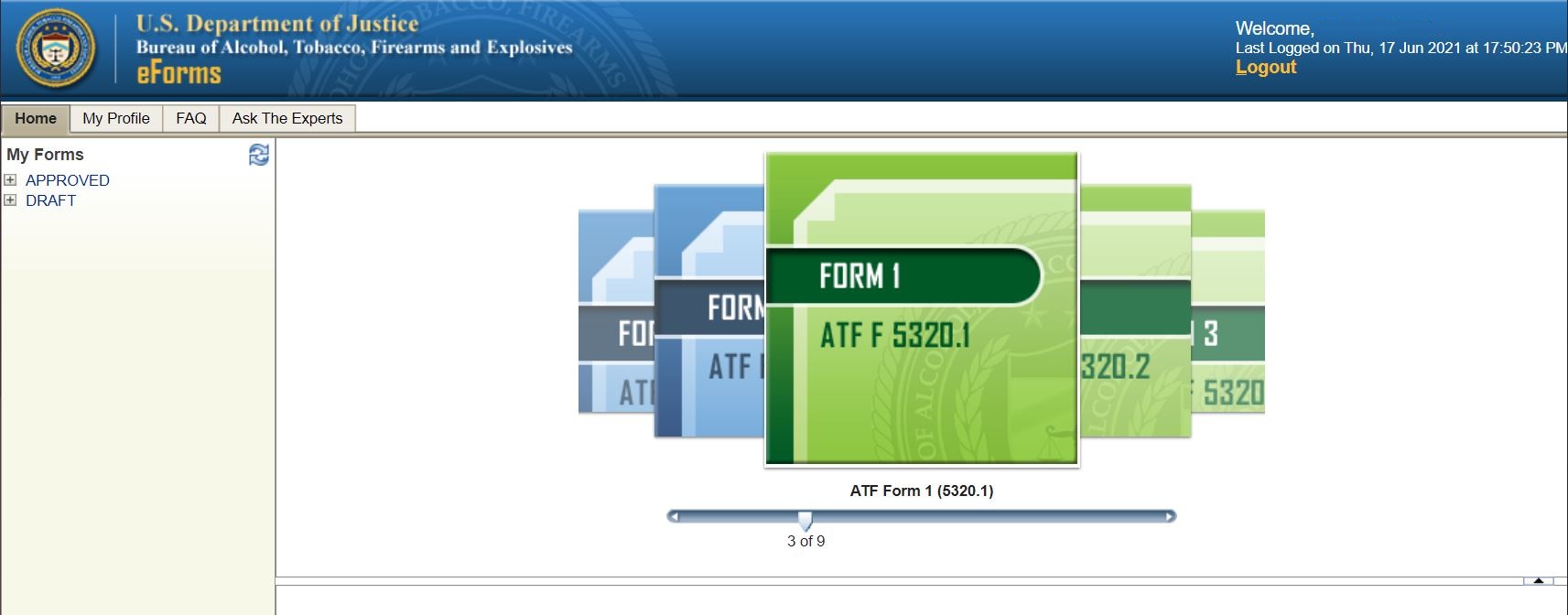
When you log in, you’ll be brought to a dashboard with a scroll bar and a series of digital applications at the top-center of the page. Click right until you find the green icon labeled “Form 1 ATF F 5320.1”. This is the application you must fill out for your SBR.
We’ve created an in-depth guide on how to complete the application below!
Part 1: Starting The Form 1 Application.
Part 2. Payment And Applicant Info.
Trusts: Responsible Persons Questionnaire.
Part 3. Responsible Person Page.
Part 4. Chief Law Enforcement Officer Page.
Part 5. Line Item Page (Adding Your SBR).
Part 6. Electronic Documents Page (Trusts Only).
Part 7. Paying For And Submitting The Application.
4. Roll and Mail Fingerprints
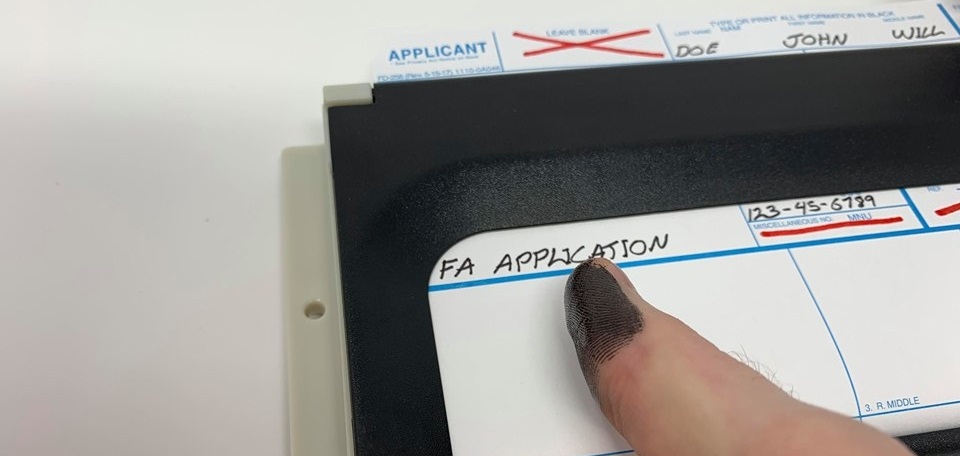
Two sets of FD-258 fingerprint cards need to accompany your Form 1 application by mailing them to the ATF. You Can Order Fingerprint Cards For Free From The FBI by calling 304-625-5590. Ordering cards from the FBI will take approximately one to two weeks for processing and shipping. You can Purchase An FD-258 Fingerprinting Kit Off Amazon, too. The kit comes with ink and five cards.
How to Mail Your Prints
After you submit your Form 1 application, you’ll receive an email notifying you that your application is in a “PENDING RESEARCH” status. During this time, the application will be reviewed by the ATF. Once the application has been reviewed and the ATF determines information has been entered correctly, your application will go into a “PROCESSING” status. When this happens, you’ll receive a second email with a cover letter attached. The cover letter has instructions for mailing your fingerprints. You must mail two sets of prints with this cover letter to the address provided on the letter.
You’ll typically receive the cover cover letter within 5 to 15 days of your application being submitted, if you don’t receive it immediately. If the manufacturer of your lower receiver is in the ATF’s database, you will probably receive the cover letter as soon as you submit your application.
Part 8 Of Our Guide Covers Rolling And Mailing Prints.
5. Wait for Approval
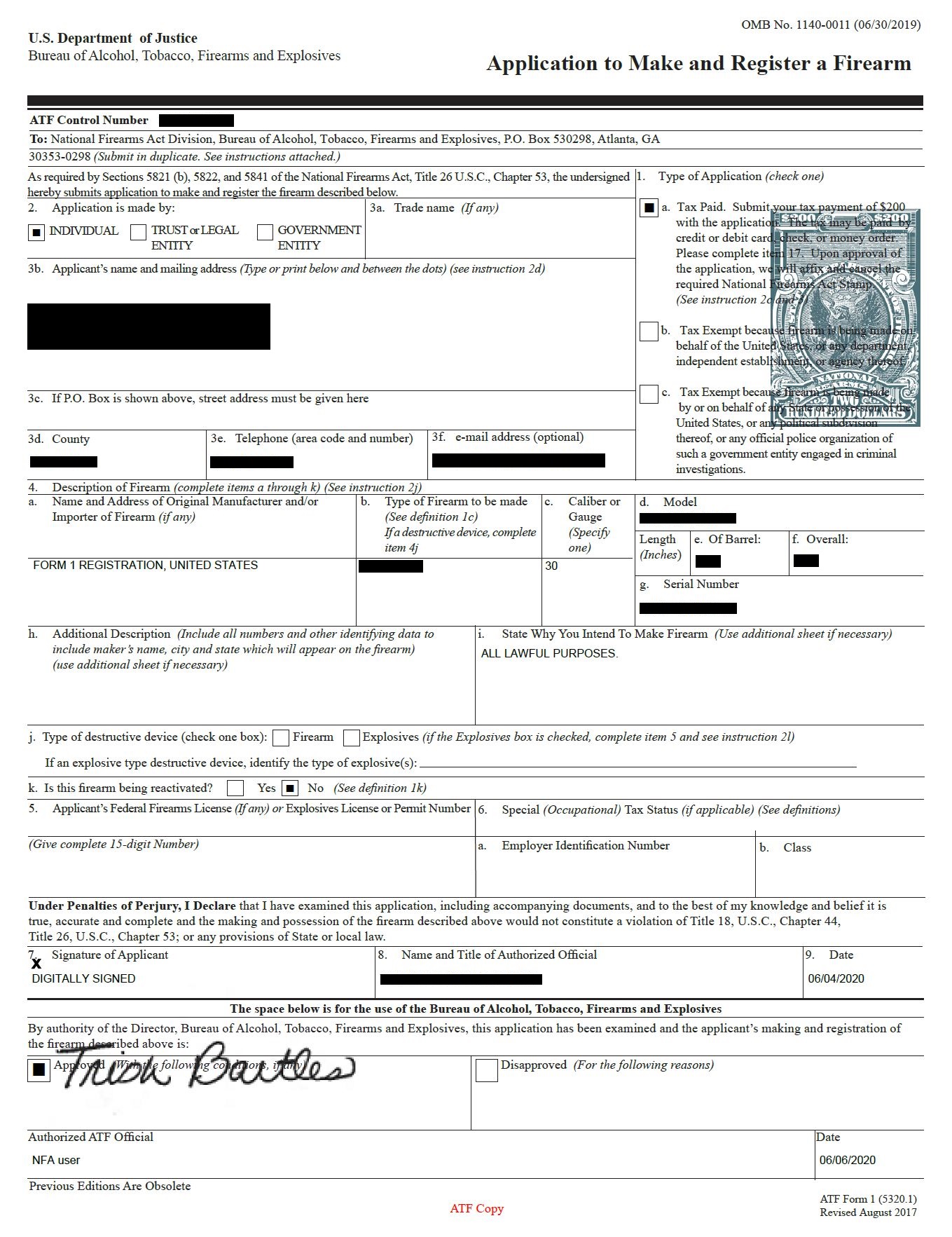
Once you mail your fingerprints, you’ll need to wait around 21 to 90 days for your SBR’s application to be approved. Once approved, the ATF will email you a third time. This email will contain a digital copy of your tax stamp, which you should print multiple copies of.
6. Get Your Receiver Engraved
NFA guns must have certain information engraved, just like any retail-bought firearm. Once your application has been approved, you must get the following information engraved on the receiver. Whether you used an 80% lower or stripped receiver, you’ll need the following info engraved to a depth of at least 0.003″ with a text height of 1/16″:
Manufacturer: That’s you! You’ll need your first and last name engraved.
Location: This would be the city and state where you live, or wherever you built your SBR. It must match the address used on your application. The state can be abbreviated.
Model: This would be the model name. If you’re using an 80% lower, you’ll engrave whatever model name you put on your application. If it’s a stripped lower you bought from an FFL, it’ll be whatever the model name that was engraved by the original manufacturer. Again, this must match what you put on the application.
Caliber: The caliber will be listed exactly as you put it on the application. The ATF no longer allows “MULTI”, so even if you’re using a stripped lower marked “MULTI”, you’ll still need to engrave the specific caliber (.30, .223, 6.5, etc).
Serial Number: You get to use whatever serial number your stripped lower came with, or you get to make up a serial number for your 80% lower. If you’re making up a serial number for an 80% receiver, it has to use alphanumeric characters without spaces. No special characters are allowed.
7. Throw On your Buttstock!
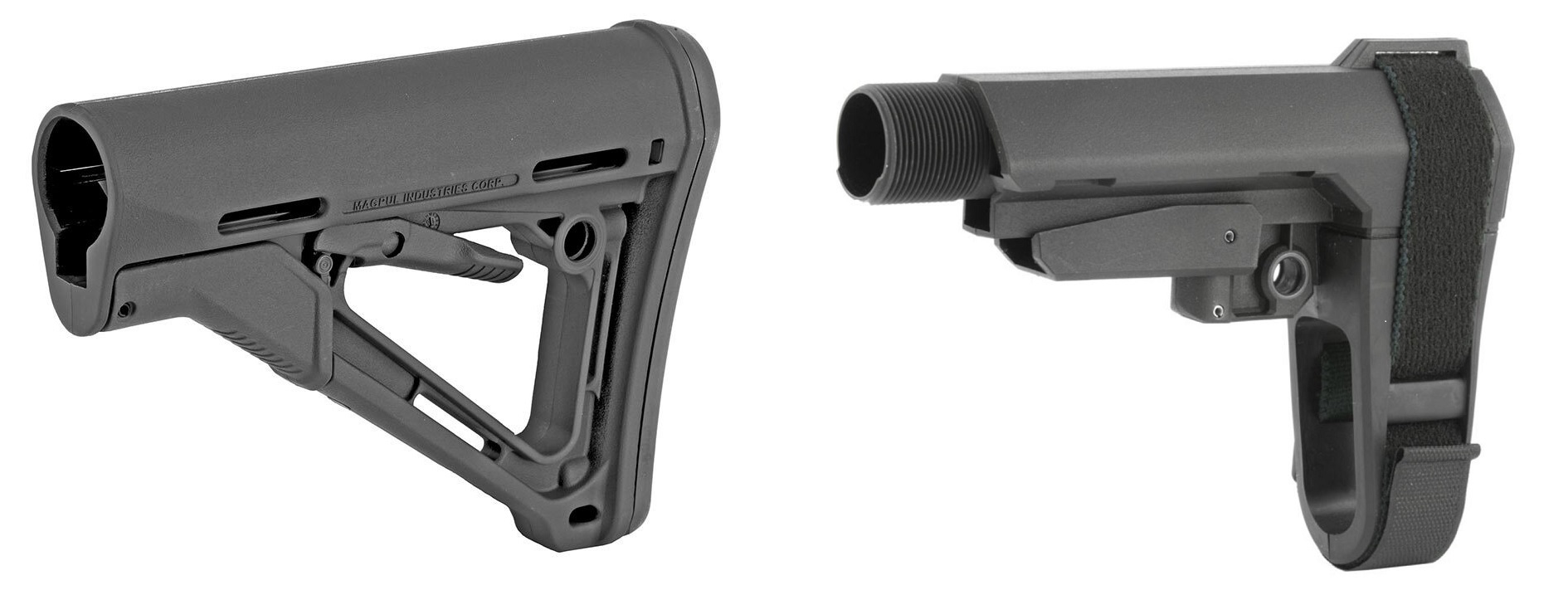
With approval and engraving requirements satisfied, you can now officially and legally transform your AR pistol into an SBR by installing your buttstock, or otherwise completing your build if you haven’t already. You can even just keep your existing pistol brace installed if you wish. After all, the ATF will likely consider most braces to be buttstocks either way.
DISCLAIMER: If you are new to the world of DIY gun building, you likely have a lot of questions and rightfully so. It’s an area that has a lot of questions that, without the correct answers, could have some serious implications. At 80-lower.com, we are by no means providing this content on our website to serve as legal advice or legal counsel. We encourage each and every builder to perform their own research around their respective State laws as well as educating themselves on the Federal laws. When performing your own research, please be sure that you are getting your information from a reliable source.



